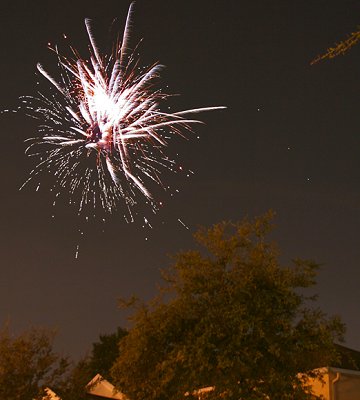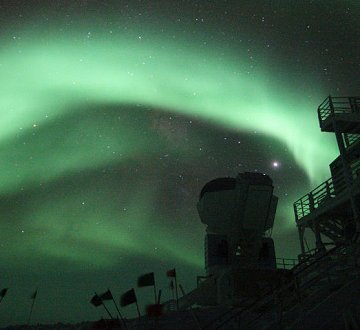| AURORA ALERTS: Did you miss the Northern Lights of June 25th? Next time get a wake-up call from Space Weather PHONE. | | | DISCOVERIES AT MERCURY: Mercury's magnetic field is "alive." Volcanic vents ring Mercury's giant Caloris basin while the planet itself is surrounded by a plasma nebula of unexpected complexity. These are just a few of the discoveries made by NASA's MESSENGER spacecraft and reported in a special July 4th issue of Science magazine. Science@NASA has the full story. PLANETS AND FIREWORKS: Not every light in the sky is an explosive. Look to the right of the fireworks in this Friday night photo from Alvaro Garay of Casselberry, Florida: 
The three starry pinpricks are Saturn, Mars and Regulus, aligned for Independence Day. "Happy 4th of July!" says Garay. Happy 5th of July, too. Tonight the same star and planets will be joined in alignment by the slender crescent Moon. If you have a backyard telescope, scan it along the line. In one quick sweep you can see the rings of Saturn, the little red disk of Mars and a grand panorama of lunar mountains and craters. The show begins after sunset: sky map. more images: from Tom J. Martinez of Oak Grove, Missouri; from Sam Cole of Austin, Texas; from Mohammad Taher Pilevar of Hamedan, Iran; from Sorin Hotea of Alanya, Turkey; from Ken Maytag of Carpinteria, California; from Pierre-Paul Feyte of La Romieu, Gascony, France; from Doug Zubenel at Shawnee State Fishing Lake, Shawnee Co., Kansas; SOUTH POLE AURORAS: Imagine walking a mile to work every day in pitch-black dark with air temperatures routinely dipping below -90 F. It might be worth if if you could look up and see this: 
Photo details: Canon Rebel XTi 400D, ISO 1600, 10mm lens, 10s, f4.0
The picture comes from Earth's south pole where "we had a nice display of aurora australis on July 5th," says J. Dana Hrubes, science leader of the Amundsen-Scott Station. Just before he took the picture, the interplanetary magnetic field (IMF) near Earth tipped south, opening a crack in our planet's magnetosphere. Solar wind poured in and fueled the auroras. "That's Jupiter shining just above the silhouette of the South Pole Telescope," he adds. Every day, Hrubes walks a mile from the main station to the telescope. "This gives me plenty of time to gaze at the sky." Of course, it is cold. "The temperature was -84 F when I took today's pictures and I have taken photos down to a temperature of -110.7 F, which is my personal all time low in early August, 2005. You have to take photos as quickly as possible; you never know what is going to freeze first, your camera or your fingers." (Note to cold-weather photographers: Hrubes uses a Canon 400D.) "We are now getting into the coldest months, July and August, where we will see temperatures below -100 F," he continues. "These are actual static temperatures, not wind chills. Furthermore, the elevation of the site is nearly 10,000 feet and we experience physiological altitudes between 10,500 ft and 12,200 ft during winter." Many people would be put off by such conditions, but not Hrubes. "In four years working here I have racked up more than 3,000 miles of walking. I am lucky to have a great walk like this to my job 7 days a week."
UPDATED: 2008 NLC Photo Gallery
[NLC Tutorial] [Night-sky Cameras] | 
